Optimization process
TwistedTexture is designed to minimize direct radiation on slabs and facades, optimizing energy efficiency. It uses sunshades and ventilated facades to reduce heat gain while maintaining natural light. The building blends with its surroundings, responding to Santiago’s climate. Advanced optimization algorithms explore various forms, balancing design complexity, compactness, and shading. The final configuration maximizes efficiency and comfort, making it a sustainable architectural landmark.
INTRODUCTION
The new office building in Santiago’s El Golf neighborhood will be situated in a high-value commercial area. The design aims to minimize direct radiation on slabs and facades, optimizing energy efficiency and thermal comfort.
Architectural strategies like sunshades and ventilated facades will reduce heat gain while maintaining natural light. The building will blend with its surroundings and efficiently respond to Santiago’s hot, dry summers and cool, wet winters.
With a contemporary, functional design, this building will be a landmark in the El Golf skyline and a model of sustainable architecture adapted to the local urban and climatic context.

Site analysis
The chosen site is a developing area designated for new commercial buildings, surrounded by the tallest buildings in Santiago. The design of this new office building aims to follow the logic of the existing structures and adequately respond to the immediate context.
Site analysis – Radiation
After conducting a radiation analysis to understand its impact on the site, it was found that the area experiences high radiation levels. Consequently, passive control systems are proposed to reduce this radiation and improve the site conditions.
Pseudo-code explanation
The pseudocode consists of 6 interconnected parts. The first part involves site analysis and optimization based on a facade radiation analysis to determine implementation location. The second part is form finding, followed by the creation of panels and shaders for solar control. Finally, it is optimized according to form finding and solar analysis to generate new forms that respond to the environment.

Design Strategies
Site analysis – offset
The strategies for site selection start by understanding the immediate context and the site’s contour. Then, an offset is generated based on the height and distance from the context to determine the separation between buildings. Finally, the site’s surface is divided to obtain possible implantation points.

Form Finding – Plan
The form-finding process starts with a polygon, from which its vertices are extracted. Circles are then generated and used in a Solid difference operation to obtain a new floor plan. This strategy is implemented to introduce movement in the facade and create a morphology that facilitates self-shading of the building.

Form Finding – Slabs
The vertical form-finding is initiated with the series component, where the height is defined based on the average of the surrounding buildings. Rotation and movement are then executed using the ‘sincus coordinalis’ component to enhance fluidity in the building.

Facade Conceptualization
A conceptualization for the facade is developed, composed of a diamond grid to provide structural integrity and aesthetic appeal. This grid serves as a framework for the creation of shaders and panels, which are strategically designed to respond to the site’s radiation requirements. These panels may incorporate adjustable blinds to optimize energy efficiency and mitigate solar glare. Additionally, simulation techniques are employed to evaluate the performance of the facade under various lighting conditions and refine its design for optimal functionality.

Facade Conceptualization – Panels
Two types of diamond-shaped panels are developed, each tailored to specific areas of the building facade: one for the straight section and another for the curved section. In the straight section, diagonal shaders are proposed to follow the grid pattern, while the curved section will consist of frames designed to respond to the solar trajectory.
Attractor point – Panels
An analysis of the solar trajectory is conducted, and based on this trajectory, attractor points are developed to vary the openings of the facade frames. In areas where more radiation is received, the frames will be smaller, while in areas with less radiation, they will be larger.

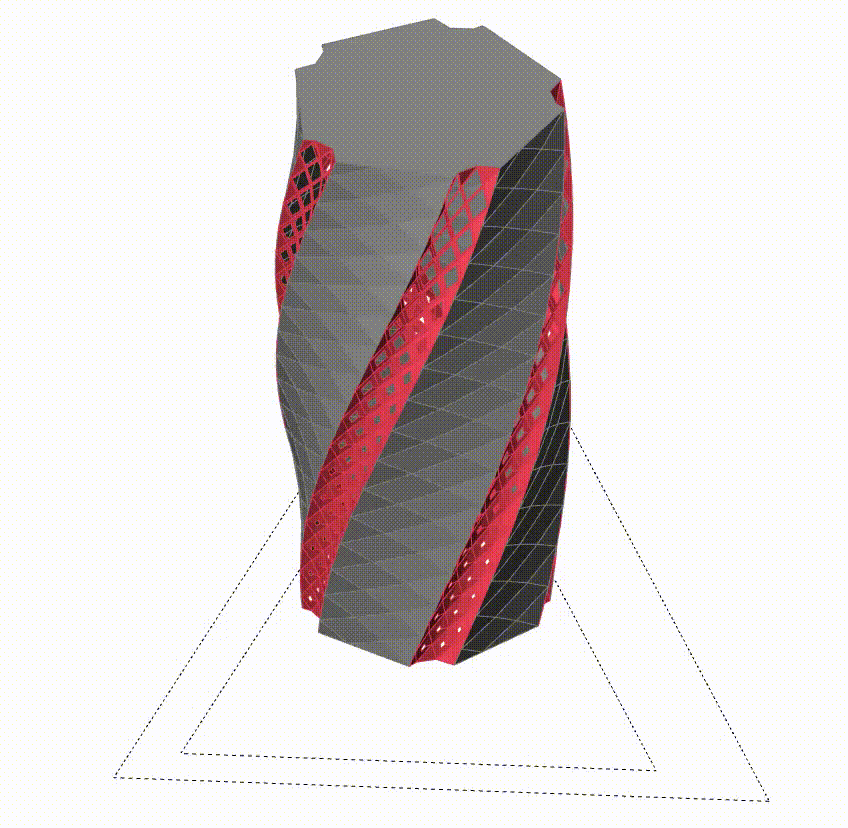
Shaders
In the other diagonal grid, diagonal shaders are proposed to respond to the grid, aiming to minimize radiation on the facade. This parametrically designed system allows for varying shadow dimensions on each side of the building, ensuring adaptability to the environment.

Design Parameters
The design parameters are developed in such a way that each one affects the other, ensuring a comprehensive and systematic development of the building. There are two types of parameters: 1) form-finding and 2) solar radiation optimization.
Parameters
Radius
Offset polygon
Polygon Side
Sinc
Rotation
Shaders extrusion
Site Location(pt)
Grid Division
Final Geometry
The final form of the building features a dynamic facade composed of a diamond-shaped panel grid. These panels, arranged in two different configurations, are strategically designed to minimize direct solar radiation and provide variable shading according to the sun’s trajectory. Developed parametrically, the geometry ensures efficient adaptation to environmental conditions, while its contemporary aesthetics enhance the urban environment

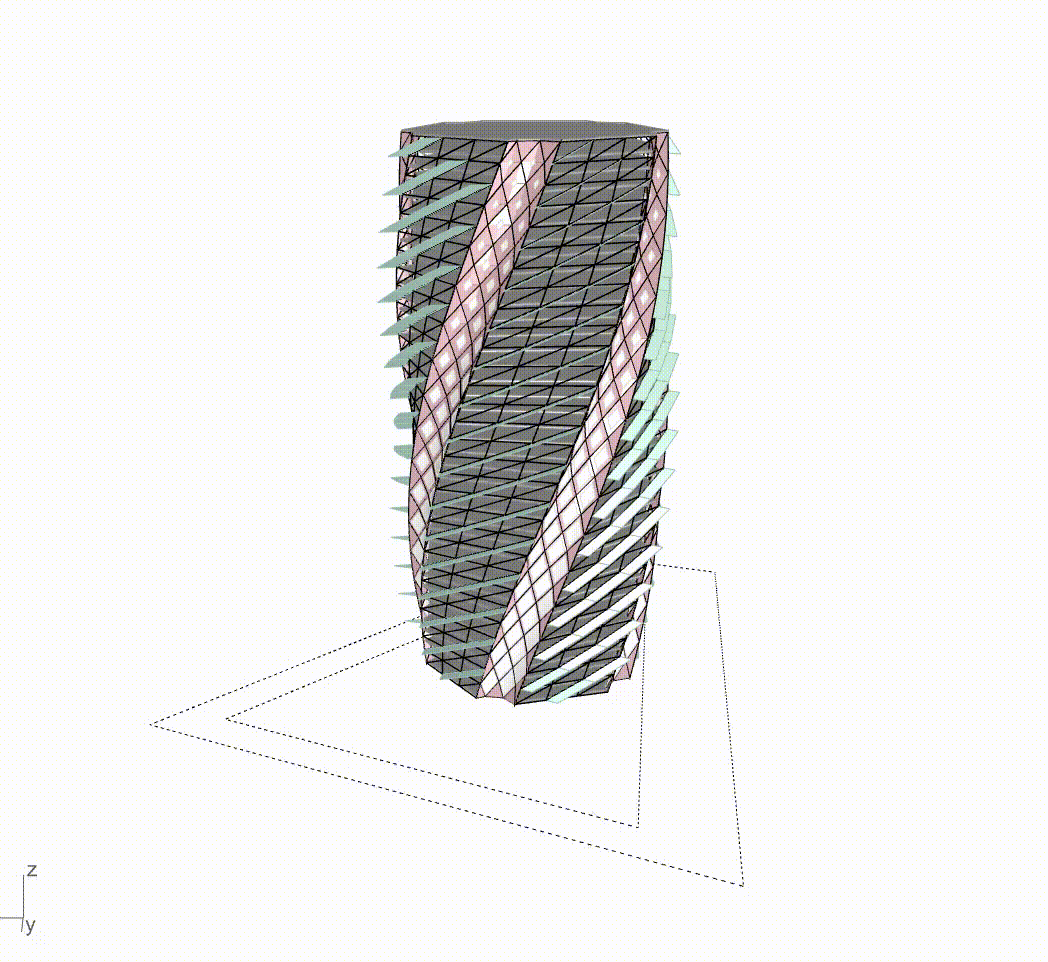
Optimization
Site _ Facade Radiation
An optimization process is undertaken based on the radiation levels on the facade to maximize sunlight exposure and consequently, daylight hours within the building. This aims to identify the best location for developing the building to effectively respond to the immediate context.

Site _ Iterations
This process is carried out using tools like Ladybug Radiation and Galapagos, which allow exploring various configurations and locations of the building. The goal is to find the optimal location for developing the building, ensuring an effective response to the immediate context and maximizing the benefit of natural light indoors. An attached GIF shows the different iterations of the optimization process, highlighting the iterative and adaptive approach to achieve the most efficient and contextually appropriate solution.
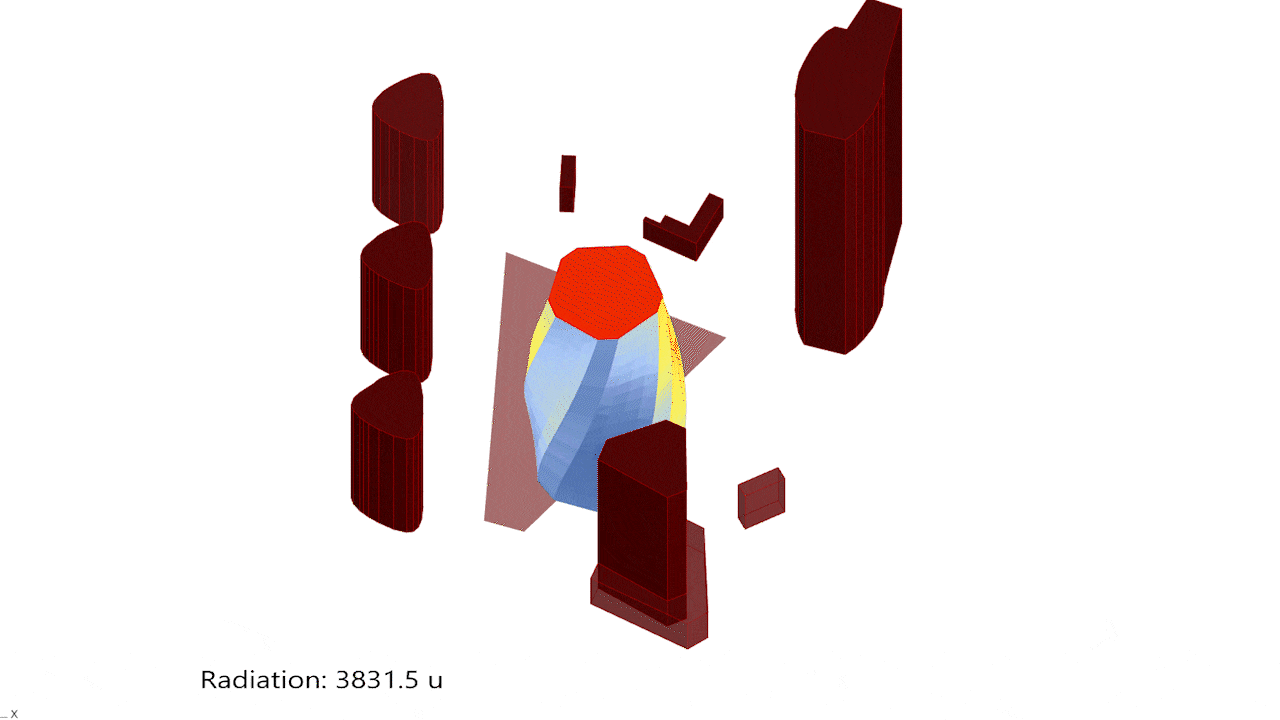
Site optimization
Best Results – Worst Results
Throughout the various iterations of the optimization process, diverse outcomes regarding radiation on the building facade were observed. The worst results, measured in terms of radiation values, ranged from 3153.114 to 3608.715, indicating relatively high exposure to direct solar radiation. Conversely, the best iterations exhibited fitness values between 3747.066 and 3831.45, suggesting a significant reduction in direct solar radiation and successful optimization of the building layout to maximize natural light utilization. These results underscore the importance of the iterative process in seeking the most suitable and efficient solution to address the project’s specific context.
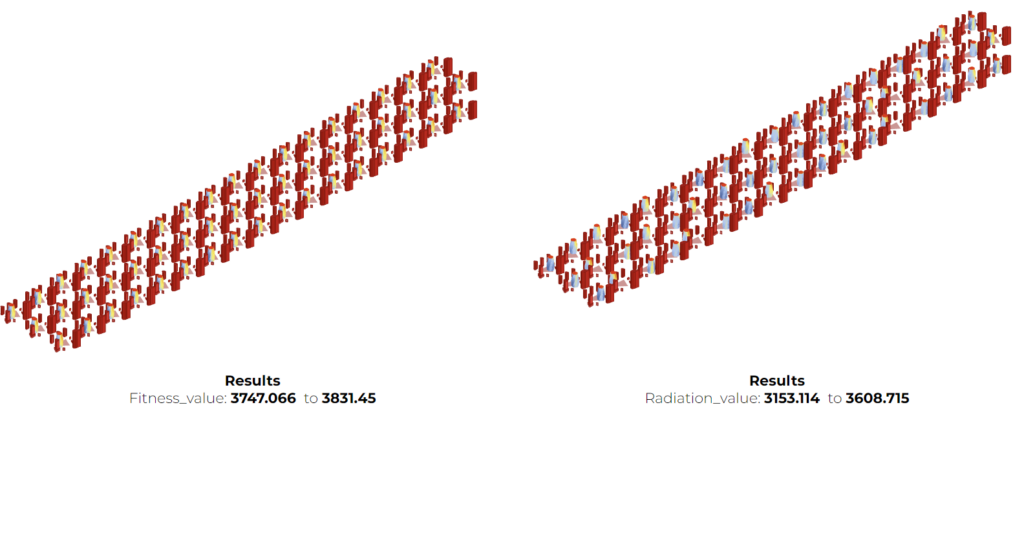
Site optimization _ Best Value
The best location for the building is situated at one end of the site, away from the taller buildings in the context. This positioning aims to receive a higher percentage of radiation on the facade, which can then be controlled through passive solar control elements.

Form finding optimization
Minimize Solar Radiation
The form-finding process of this building focuses on minimizing solar radiation, employing multiple fitness criteria to ensure an optimal and efficient design. These criteria include design complexity, compactness ratio of the area, shading devices, radiation on slabs, and radiation on the facade.
To achieve this, a variety of architectural forms and configurations are explored using advanced optimization algorithms. During each iteration of the design process, different design options are evaluated and compared based on the established fitness criteria.
Additionally, a detailed analysis is conducted on the radiation on slabs and the facade to identify areas of high solar exposure and guide the strategic dimensions of shading devices through optimization.

Form finding optimization – Shaders optimization
The parameters considered as genes for optimization are: the number of polygon sides, the radius, Sinc Value, rotation, and shader size. These elements are essential to define the shape and characteristics of the final geometry of the building.
The number of polygon sides determines the complexity and smoothness of the building’s shape, while the radius affects its scale and proportions. The Sinc Value influences the alignment and movement of the design elements.
Rotation allows adjusting the orientation of the building to better harness sunlight and minimize radiation in specific areas. Lastly, shaders are crucial for controlling the amount of light and heat entering the building, thus optimizing its energy efficiency and the thermal comfort of occupants.
These parameters are carefully adjusted and optimized during the design process to find the most suitable configuration that meets the project’s performance and aesthetic requirements.
Best Results – Worst Results
During the optimization process, different configurations of the building were evaluated, with some achieving better results than others. The best-performing ones, with Fitness values ranging from 2.65994 to 2.88176, are characterized by having a moderate Sinc Value and shaders that effectively respond to the solar trajectory. Additionally, they feature an intermediate rotation that allows for better utilization of sunlight without creating excessive shadows.
On the other hand, the worst-performing results, with Fitness values between 2.263662 and 2.295926, are attributed to excessive rotation, a small Sinc Value, and shaders of reduced size. These configurations do not adequately respond to solar radiation, resulting in lower energy efficiency and less thermal comfort inside the building.

Best Result
The optimal building configuration is characterized by a balanced combination that maximizes energy efficiency (radiation) and design parameters. This setup allows for an even distribution of sunlight and adequate ventilation, optimizing sunlight capture without generating excessive shadows. Additionally, it provides effective control over direct solar radiation, ensuring a comfortable indoor environment.

Parameters_Values
The following values determine the shape, scale, and characteristics of the architectural elements, such as the polygon sides, radius, rotation, and the quantity of shading elements in different areas of the building. Each parameter and its value contribute to optimizing the design to maximize energy efficiency and thermal comfort in the building.
Polygon: 5 Sides – Radius: 32 – Sinc: 1.4 – Rotation: 57
Shaders A: 6 – Shaders B: 4 – Shaders C: 4 – Shaders D: 2 – Shaders E: 2
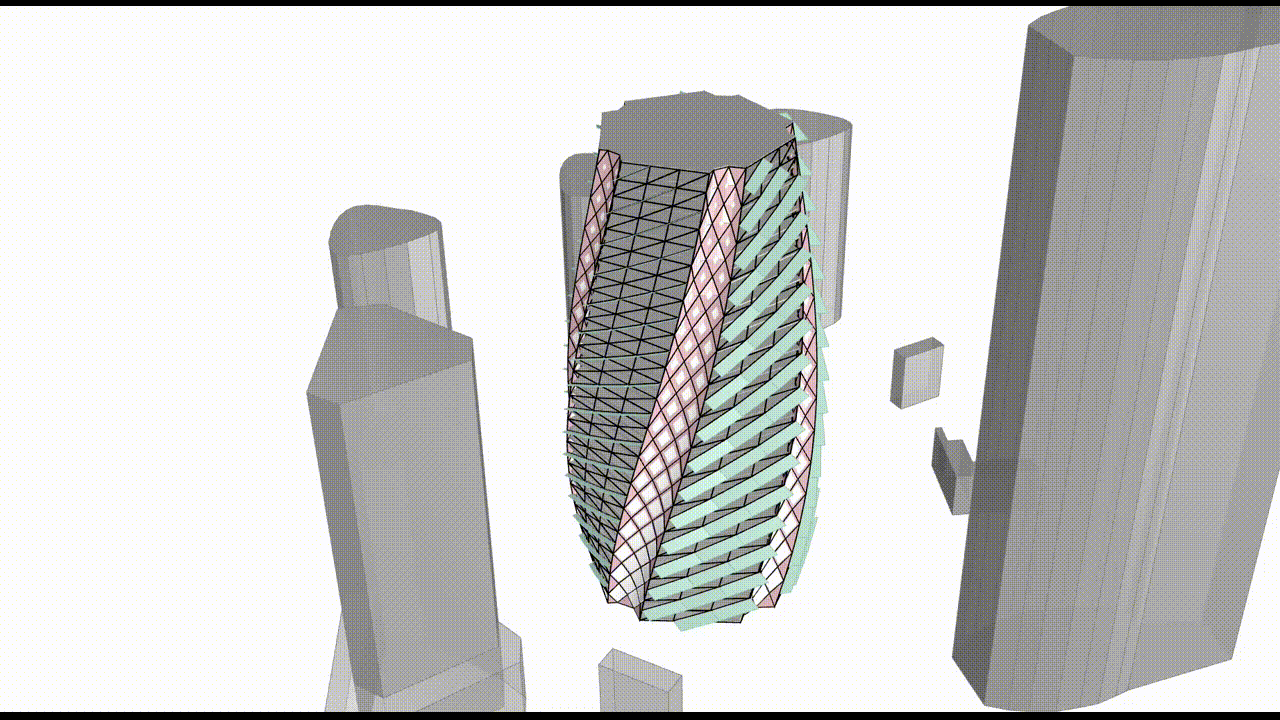
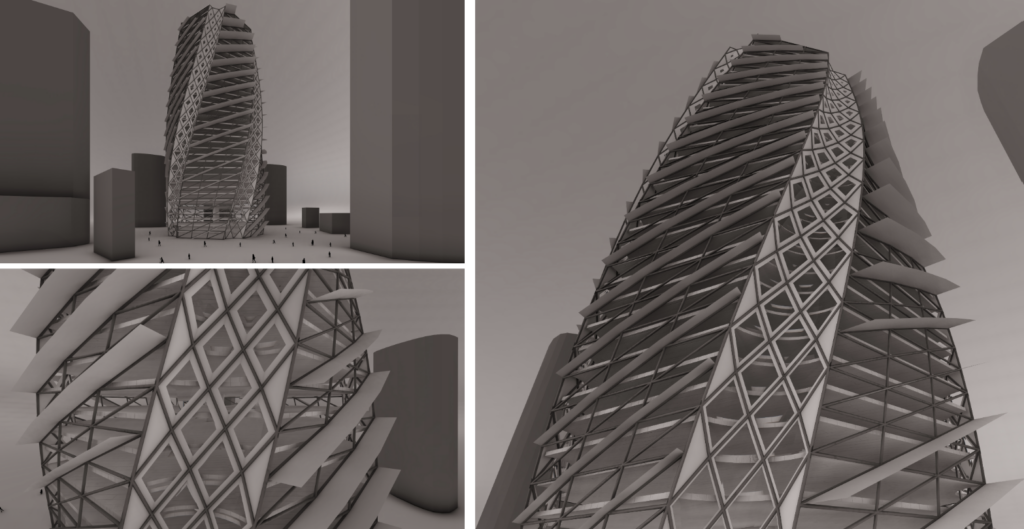
CONCLUSION
In summary, the project has successfully developed an architectural configuration that not only effectively addresses the demands for energy efficiency and thermal comfort but also reflects a harmonious balance between functionality and aesthetics. The optimization process has been essential in achieving this outcome, allowing for the exploration and evaluation of various configurations to find the most suitable one. By integrating design criteria and specific parameters, energy efficiency has been maximized and environmental impact minimized, creating a built environment that not only meets functional needs but also positively contributes to the surrounding environment.

